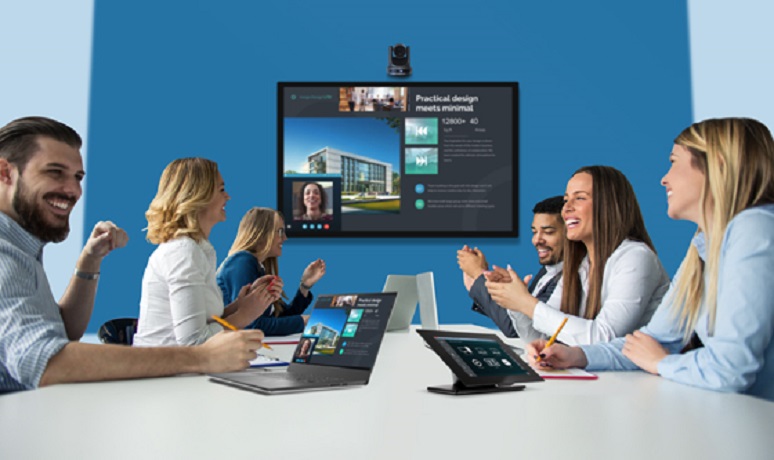Consistent user-experience is a factor often overlooked when deploying soft-codec video conferencing solutions (like Zoom, Microsoft Teams, GoToMeeting, etc.) across an enterprise. While these solutions work well in small huddle rooms or at a user’s desk, they do not offer the same experience in medium- to large-size meeting rooms, training areas, or all-hands areas.
On the integration side, one-to-one technologies like HDMI and USB have inherent length limitations that force internal AV/IT support and integrators to rely on unreliable (and expensive) USB extenders and HDMI matrix switchers when scaling these solutions. These piecemeal compromises ultimately lead to untimely hiccups and failures when end users try to engage with the technology.
Even if the room is technically operational, you also have to consider the end user awareness of how to use the entire system. In addition to starting the soft-codec application, end users of these larger meeting rooms typically need to interact with a second platform, namely an audio DSP and control system. Without proper integration and automation, the end user is forced to jump between starting the video conference application and fiddling with the room’s lighting, sound, screens and other third-party devices. This scenario assumes a firm understanding of both systems on the part of the end user and puts the fate of the meeting at risk (ultimately increasing the likelihood of support calls to make up for the failings of the in-room technology, poor room design, and unrealistic end user expectations).
So, how do you solve this?
To ensure end user productivity, it’s important to seek out AV solutions that offer tighter (and simpler) integration with third-party soft-codec video applications. This can go beyond simply replicating the user experience in larger spaces. Look for solutions that avoid piecemeal connectivity compromises (avoid USB/HDMI for long transport) and instead aim for AV solutions that take full advantage of modern, IT standard networked technologies. Also consider how to unify and automate end user interactions with those secondary AV systems for larger rooms with the functionalities of the soft-codec application.
At QSC, we address these challenges with the Q-SYS Ecosystem. The software-based audio, video and control (AV&C) solution is built on standard IT architecture, offering much more functionality than traditional AV solutions, with much less hardware. By integrating AV&C into a single processor, offering native meeting room peripherals along with third-party device control, and leveraging the power of standard converged networks, Q-SYS offers simpler integration and automation opportunities for those larger meeting spaces.
Furthermore, Q-SYS can take advantage of available APIs from soft codecs like Zoom to allow native control of major application functions and integrate those controls with the AV system’s audio/video/environmental controls onto a single GUI. Your end users will experience greater confidence and ease as they launch and control all elements of their meeting from a touchscreen display that has been designed to emulate the functionality and aesthetic familiarity of their soft-codec application.
As you consider how best to deploy a soft-codec video conferencing solution, think about the enterprise as a whole, rather than each space individually. A consistent user-experience keeps meetings productive and the end user happy.









